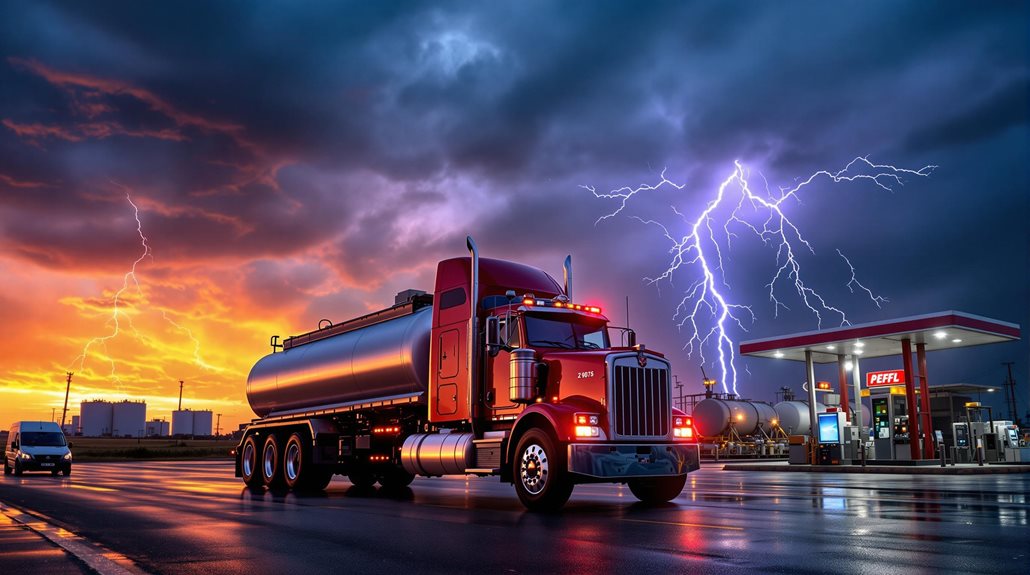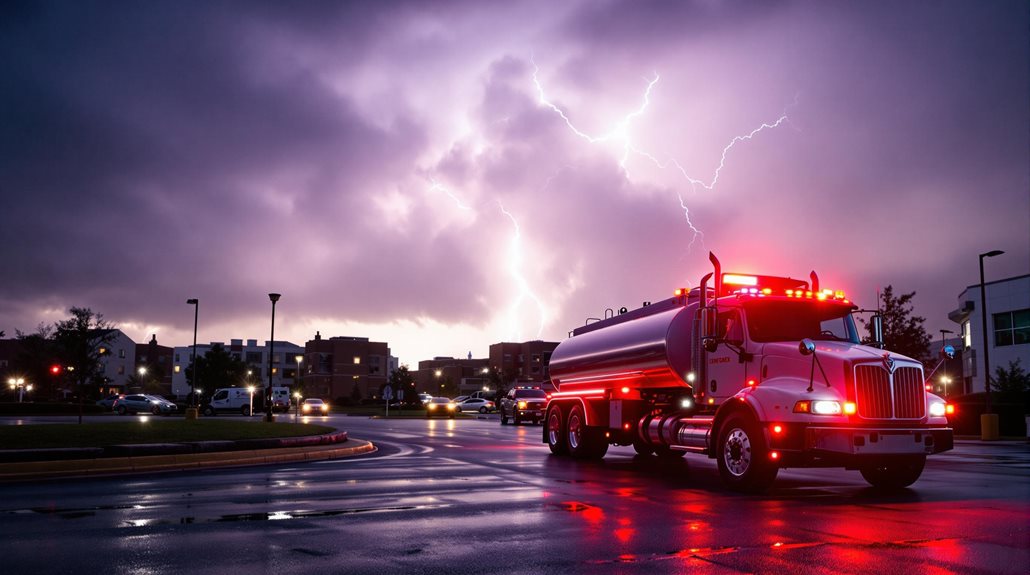Reliable fuel delivery during emergencies is fundamental to maintaining critical infrastructure and essential community services. Healthcare facilities depend on consistent fuel supplies to operate life-saving equipment and backup generators, while emergency response teams require uninterrupted access to fuel for their vehicles and operations. The Department of Homeland Security coordinates public-private partnerships to guarantee fuel delivery systems remain operational during crises, supporting everything from hospitals to emergency services. Statistics show that response delays can increase mortality rates by 1-2% per minute, making effective fuel delivery systems indispensable for saving lives. Understanding these systems reveals how communities maintain resilience during challenging times.
Expert Highlights
- Fuel delivery ensures hospitals can operate life-saving equipment and maintain essential medical services without interruption during emergencies.
- Emergency response vehicles require reliable fuel supply to perform critical rescue operations and respond to urgent calls.
- Backup generators at healthcare facilities depend on continuous fuel delivery for power, temperature control, and medical equipment operation.
- Critical infrastructure facilities need steady fuel supply to maintain vital community services during disasters and emergency situations.
- Strategic fuel delivery systems reduce emergency response times, preventing increased mortality rates and healthcare costs during crises.
Emergency Fuel's Critical Role

In times of crisis, emergency fuel delivery serves as the backbone of essential operations across multiple sectors. From powering critical hospital systems and life-support equipment to maintaining communication networks and data centers, fuel delivery upholds uninterrupted service during emergencies. The continuous operation of emergency vehicles, generators, and heating systems depends entirely on reliable fuel supplies. Advanced monitoring systems help track fuel levels and coordinate timely deliveries during crisis situations. Maintaining clean, uncontaminated fuel through proper housekeeping is vital to prevent generator failures during critical moments. The 24/7 emergency services such as fuel delivery ensure that communities remain resilient and adaptable during unforeseen events. This crucial service extends beyond immediate emergency response, supporting the broader infrastructure that communities rely upon. Emergency fuel delivery enables logistics networks to transport essential goods and relief materials, while guaranteeing that retail outlets remain operational during periods of high demand or supply chain disruption.
Powering Through Natural Disasters
Natural disasters pose significant challenges to power infrastructure, prompting utilities and emergency responders to implement robust resilience strategies. Infrastructure hardening measures, including elevated substations and reinforced transmission lines, serve as the first line of defense against severe weather events. Climate change impacts are placing unprecedented strain on the aging power grid that was largely built in the 1900s. Successful disaster response efforts rely on strong stakeholder relationships between federal, industry, and local entities. Employing emergency situation roadside help can ensure timely fuel delivery in times of need, aiding utilities in their disaster management efforts.
Additionally, the integration of microgrids and distributed energy resources has proven instrumental in maintaining power reliability during grid failures. Advanced monitoring systems, utilizing satellite links and fiber optics, enable utilities to detect and respond to disruptions efficiently.
With severe weather accounting for 83% of power outages between 2000 and 2021, organizations are increasingly adopting thorough approaches that combine traditional infrastructure improvements with smart grid technologies. The implementation of on-site renewable systems with battery storage further enhances community resilience, ensuring continuous power supply during emergencies.
Business Continuity During Crisis

During periods of crisis, businesses face the critical challenge of maintaining revenue streams while protecting their essential operations through reliable emergency power systems. Implementing thorough/extensive/detailed emergency power protection strategies, including redundant fuel delivery systems and backup power solutions, enables organizations to maintain their core functions and preserve their bottom line even in the face of severe disruptions. A reliable on-site gas delivery service can provide critical support in ensuring that backup generators remain operational, delivering a variety of fuel types with competitive pricing and prompt efficiency. A well-maintained system ensures seamless functionality across all operational areas. Strategic supply chain management, particularly in fuel delivery partnerships, serves as a cornerstone for business resilience, ensuring that organizations can sustain their operations and meet customer obligations throughout extended emergency situations.
Preserving Revenue During Disasters
Business survival during disasters hinges on a well-structured continuity plan that safeguards revenue streams and operational stability. Statistical evidence indicates that organizations without thorough business continuity planning face a 90% failure rate within one year of experiencing a major disaster. Implementing robust financial protection measures guarantees sustained market position and stakeholder confidence during critical periods.
| Impact Area | Risk Mitigation | Revenue Protection |
|---|---|---|
| Operations | Emergency Response Plans | Minimize Disruption Costs |
| Supply Chain | Backup Vendor Network | Maintain Product Flow |
| IT Systems | Data Recovery Protocols | Preserve Transaction Capability |
| Workforce | Remote Work Solutions | Ensure Productivity Continuity |
Strategic implementation of these measures, combined with effective communication channels and rapid restoration protocols, enables organizations to maintain financial viability while protecting their market position and reputation throughout the crisis period.
Emergency Power Protection Strategies
In the face of power disruptions, organizations must implement thorough emergency power protection strategies to maintain operational resilience and business continuity. A comprehensive approach includes deploying multiple layers of backup power systems, from UPS units for immediate protection to standby generators for extended outages.
Organizations should integrate renewable energy sources and microgrids to enhance power reliability while reducing dependence on traditional grid systems.
Regular maintenance protocols, including systematic testing of batteries, generators, and electrical infrastructure, are essential for ensuring these systems perform at their best during emergencies. Companies must also develop detailed business impact assessments that identify critical operations requiring uninterrupted power supply.
This assessment should inform the creation of robust emergency response plans, incorporating clear communication protocols and resource allocation strategies to maintain essential business functions during power-related incidents.
Strategic Supply Chain Management
Strategic supply chain management has become paramount for organizations seeking to maintain operational continuity during crises. By implementing thorough supplier diversification strategies and maintaining flexible procurement channels, organizations can drastically reduce their vulnerability to disruptions in fuel delivery systems. Companies that establish redundant supply networks and maintain robust communication protocols with multiple vendors demonstrate enhanced resilience during emergencies.
The integration of agile sourcing practices, coupled with strategic inventory management, enables organizations to respond effectively to sudden demand fluctuations and geopolitical challenges. This approach necessitates careful consideration of regulatory compliance, environmental factors, and technological capabilities while balancing cost efficiencies with risk mitigation. Through systematic evaluation of supplier relationships and continuous monitoring of global market conditions, organizations can guarantee reliable fuel delivery even during unprecedented scenarios.
Maintaining Essential Community Services
The continuous supply of fuel during emergencies plays a pivotal role in maintaining critical infrastructure, enabling hospitals to operate life-saving equipment and ensuring that emergency response teams can perform their duties without interruption. Healthcare facilities rely heavily on reliable fuel delivery to power backup generators, maintain proper indoor temperatures, and sustain essential medical services for vulnerable populations. Through strategic fuel delivery systems, emergency response teams can maintain readiness while supporting temporary shelters and community centers, thereby strengthening the overall resilience of local communities during crisis situations. Additionally, 24/7 roadside assistance coverage can play a crucial role in providing timely fuel delivery during emergencies, ensuring that residents and emergency vehicles are never without the resources needed to navigate throughout Minnesota.
Critical Infrastructure Support
Modern cities rely on a complex web of critical infrastructure that must remain operational during emergencies, particularly when fuel delivery becomes indispensable for preserving integral community services. The Department of Homeland Security coordinates with public and private sector partners to safeguard the protection and resilience of these vital systems, while Emergency Support Functions align with Critical Infrastructure and Key Resources sectors to facilitate seamless integration during crisis response.
Local governments, working in conjunction with the Emergency Services Sector, bear primary responsibility for sustaining critical infrastructure operations through thorough risk assessment protocols and vulnerability management strategies. This coordinated approach, supported by information-sharing networks and sector-specific plans, enables communities to maintain essential services and respond effectively to disruptions in fuel delivery systems while safeguarding critical facilities and supporting emergency response capabilities.
Healthcare System Continuity
Healthcare facilities represent cornerstones of community resilience during emergencies, requiring robust fuel delivery systems to maintain uninterrupted medical services and life-sustaining operations. These institutions must protect essential functions through comprehensive continuity planning, which encompasses critical infrastructure support, telecommunications, and clinical operations.
To guarantee seamless healthcare delivery during crises, organizations implement redundant systems for mission-critical functions while establishing clear protocols for emergency communication and coordination. The Clinical Continuity Plan serves as the foundational framework, detailing response strategies for various scenarios, including cyberattacks and infrastructure failures.
Priority is given to protecting electronic medical records, maintaining patient care services, and preserving essential support functions such as power generation and HVAC systems. Through coordinated efforts with community incident command, healthcare facilities can sustain critical services during emergencies.
Emergency Response Readiness
Effective emergency response readiness demands a thorough, multi-faceted approach to maintaining essential community services during crises. Through strategic partnerships with local organizations and emergency response teams, communities can establish robust systems for resource allocation and communication.
This comprehensive framework safeguards the continuous delivery of critical services while addressing the diverse needs of all community members.
Key components of emergency response preparedness include:
- Implementation of integrated communication systems utilizing FEMA's IPAWS
- Development of tailored plans for vulnerable populations
- Establishment of resource distribution networks for essential supplies
The success of emergency response initiatives relies heavily on continuous training programs, regular community-wide drills, and the effective coordination between emergency operations centers and local service providers. This systematic approach enables communities to maintain critical services during emergencies while guaranteeing no segment of the population is overlooked.
Emergency Response Time Matters

During life-threatening emergencies, every passing minute can mean the difference between life and death. Studies demonstrate that mortality rates increase by 1-2% for each minute of delay, while healthcare costs surge by 7% per minute of delayed response. These critical moments profoundly impact patient outcomes, particularly in cardiac and neurological emergencies, where rapid intervention within the first five minutes is essential for survival. Professional roadside services also ensure that potential expensive and life-threatening consequences are avoided by providing essential support like tire changes and fuel delivery.
| Time Factor | Impact on Life | Financial Impact |
|---|---|---|
| 1 Minute Delay | 1-2% mortality increase | 7% cost increase |
| 4 Minutes | Ideal survival window | $1,542 savings per cardiac case |
| 5 Minutes | Vital intervention period | Reduced ICU costs |
| 8 Minutes | Urban response benchmark | Lower treatment expenses |
| 9 Minutes | Fire flashover point | Substantial property damage |
The strategic placement of emergency response resources and efficient fuel delivery systems becomes paramount in minimizing these critical response times.
Planning For The Unexpected
In times of crisis, detailed planning for fuel delivery becomes a cornerstone of emergency preparedness. Organizations must develop thorough strategies that incorporate customized emergency plans, pre-emptive fueling protocols, and robust logistics networks to guarantee uninterrupted operations during unexpected events.
Located north of the University of Minnesota's Twin Cities campus, Dinkytown is a vibrant area where residents benefit from dependable roadside assistance services like gas delivery, crucial for maintaining normalcy during emergencies.
By partnering with reliable emergency fuel suppliers, businesses can establish resilient contingency measures that protect critical infrastructure and maintain essential services.
Essential components of emergency fuel planning include:
- Implementing automated tank monitoring systems for proactive inventory management
- Establishing predetermined delivery schedules aligned with peak demand periods
- Developing multiple contingency routes and backup supply chain solutions
This systematic approach to fuel management enables organizations to maintain business continuity while meeting regulatory requirements and protecting valuable assets. Through careful planning and partnership with experienced providers, companies can effectively navigate challenging circumstances while ensuring operational stability.
Roadside Assistance FAQ
How Long Can Diesel Fuel Be Stored Before It Needs to Be Replaced?
Diesel fuel typically lasts 6-12 months in standard storage conditions. With proper maintenance, stabilizers, and ideal storage practices, it can remain usable for up to 18-24 months before replacement.
What Happens if Emergency Fuel Delivery Vehicles Break Down During a Crisis?
Emergency fuel delivery vehicle breakdowns can severely impact critical services, leading to disrupted medical care, compromised emergency response capabilities, and potential safety risks for communities relying on essential fuel supplies.
Are There Different Types of Emergency Fuel Available for Various Equipment?
Yes, multiple emergency fuel types are available, including diesel for generators, JetA/AvGas for aviation, natural gas for pipeline-connected equipment, and propane/DEF for specialized operational needs.
Can Emergency Fuel Deliveries Be Scheduled in Advance of Predicted Disasters?
Yes, emergency fuel deliveries can be scheduled proactively before predicted disasters through customized business continuity plans, advanced tank monitoring systems, and priority scheduling services to guarantee continuous fuel availability.
What Documentation Is Required to Qualify for Emergency Fuel Delivery Services?
Essential documentation includes service agreements, emergency contact information, detailed fuel specifications, safety compliance certificates, and proof of insurance coverage to establish eligibility for emergency fuel delivery services.
